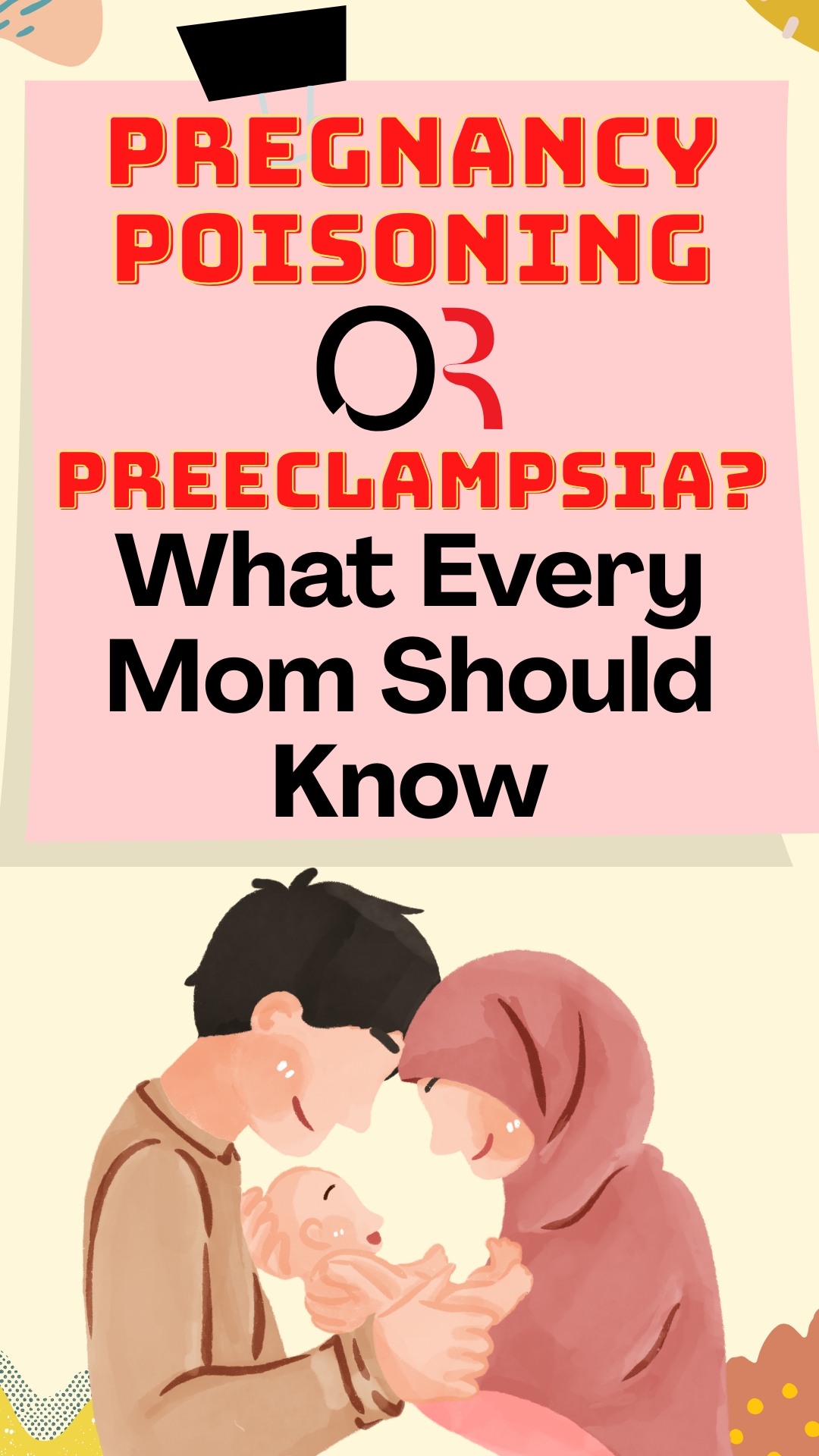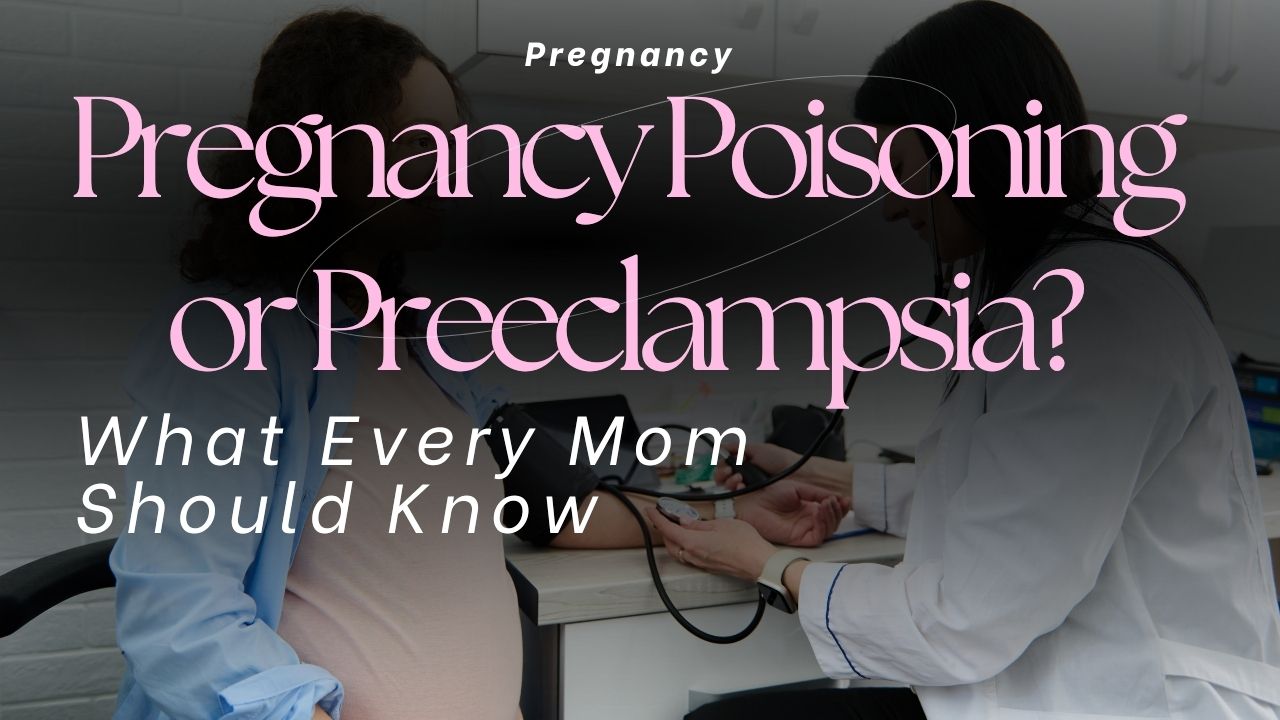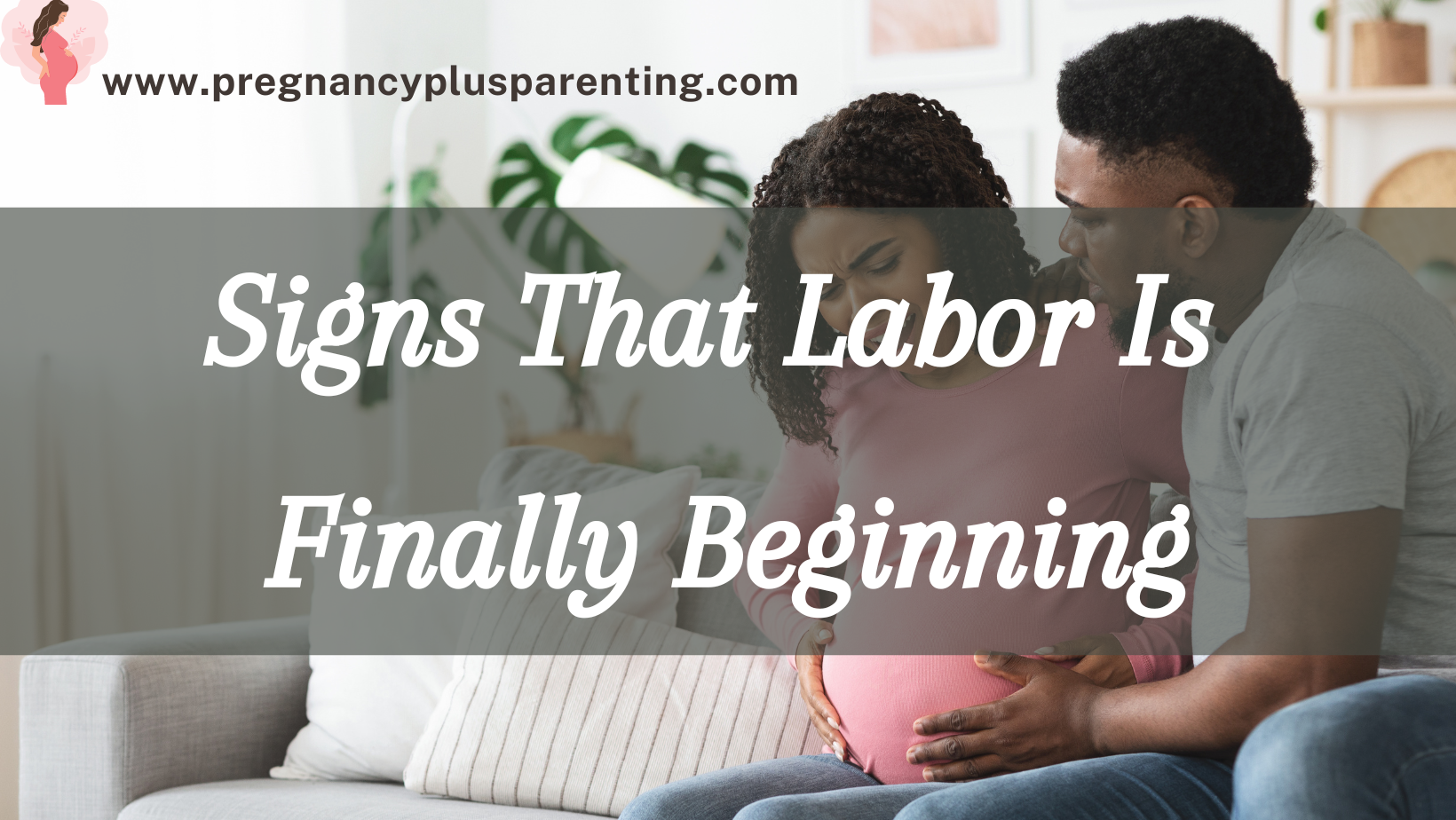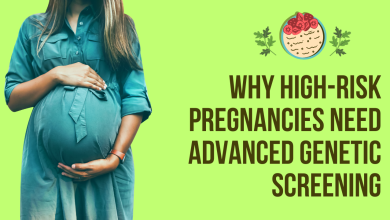Pregnancy Poisoning or Preeclampsia? What Every Mom Should Know
What is preeclampsia, preeclampsia, or pregnancy poisoning? What symptoms do they entail, and are there certain risk factors that contribute to their occurrence?
Is it dangerous for you and your baby and how is it treated?
You are pregnant, are of course happy about it and have now started to inform yourself about the complications that can occur and how to prevent them and have come across the terms mentioned above?
Even though it only affects a few women, you should know the facts about the different forms of pregnancy poisoning, especially at the beginning of your pregnancy.
In this article you will find all the important information.
What is pregnancy poisoning?
Even though the term pregnancy poisoning is outdated, it is often used colloquially.
It comes from the fact that there used to be theories that certain substances present in the body during pregnancy could cause poisoning.
Nowadays, science knows better and believes that it is an adjustment disorder of the body, which changes during pregnancy.
Gestoses are diseases that are only triggered by pregnancy.
Nausea during pregnancy and morning vomiting, which usually occur between the second and fourth month of pregnancy, are among the so-called early gestosis.
Pregnancy poisoning can occur after the 20th week of pregnancy (GW) and is one of the late gestosis, which is also known as hypertensive pregnancy diseases.
This is because all of these cases are associated with high blood pressure (hypertension).
The so-called late gestosis also includes HELLP syndrome (severe disorder of blood clotting and liver function), eclampsia (seizures), preeclampsia or EPH gestosis, plug gestosis and gestational hypertension or gestational hypertension.
How often does pregnancy poisoning occur?
A full six to eight percent of pregnant women suffer from pregnancy poisoning, which is one of the most common causes of expectant mothers dying during pregnancy.
High blood pressure develops into preeclampsia in almost half of affected pregnant women, while in ten percent of these pregnancies the disease takes a severe course.
Across Europe, about two percent of all pregnant women experience preeclampsia, which can develop into HELLP syndrome.
Worldwide, 70,000 women die from the consequences of preeclampsia, particularly in developing countries. In Germany, five to ten percent suffer from it.
Women who suffer from high blood pressure before pregnancy and who continue to have it for more than twelve weeks after delivery have chronic hypertension.
In one in four such women, this can develop into plug eclampsia during pregnancy.
Who is particularly affected by pregnancy poisoning?
As with all diseases, there are certain factors that favor the occurrence of pregnancy poisoning.
If preeclampsia occurred in a previous pregnancy, there is a higher chance that it will happen again in the next one.
Other risk factors include multiple pregnancies , the age of the pregnant woman (either under 18 or over 40 years old ), diabetes mellitus, autoimmune diseases, the presence of preeclampsia in close relatives, obesity, kidney disease and blood clotting disorders.
Pregnancy poisoning – symptoms, signs and consequences
The disease develops with the formation of the placenta, and symptoms are rarely detected before the 20th week of pregnancy. Sometimes women show no noticeable symptoms at all, which makes this disease particularly insidious.
Therefore, it is important to have regular checkups with your gynecologist, because gynecology has the ability to identify this disease.
A typical sign of preeclampsia is high blood pressure (over 140/90 mmHg). All other symptoms depend on the type of preeclampsia.
Preeclampsia and eclampsia involve proteinuria, or protein in the urine. Eclampsia also causes life-threatening seizures.
Even if there is no protein in the urine, preeclampsia may still be present if other symptoms are present.
These include water retention in the lungs, impaired kidney function, visual disturbances and delayed growth of the unborn child.
Preeclampsia is considered severe when blood pressure levels are above 160/100 mmHg, kidney damage causes a decrease in urine output, liver damage causes upper abdominal pain, platelet count is reduced, and severe headaches occur in addition to visual disturbances.
In the type of pregnancy poisoning called eclampsia, in addition to the symptoms of preeclampsia, there is also what is known as a tonic-clonic seizure.
“Tonic” means that there is increased adaptation of the muscles and “clonic” means that there are rhythmic and involuntary muscle twitches.
During such a seizure, the affected person opens their eyes wide and lets out a scream, followed by muscle twitches, which can be life-threatening.
The so-called HELLP syndrome also results in a reduced number of platelets, as well as increased liver enzymes and the dissolution of red blood cells.
Now the liver function is disturbed and this is noticeable through severe right-sided upper abdominal pain or pain behind the sternum.
This disease progresses in phases, but also continuously and can spontaneously worsen or improve.
It becomes particularly dangerous when the blood clots so strongly that after a while many platelets are used up.
Even the slightest injury to the blood vessels can cause life-threatening bleeding, with cerebral hemorrhage being particularly dangerous if blood pressure is high.
In addition to these risks, HELLP syndrome can also lead to kidney failure, placental rupture, and liver rupture.
Signs of pregnancy poisoning also include confusion, dizziness, eye flickering and increased sensitivity to light, as well as increased reflexes, which the doctor examines with a reflex hammer.
Because symptoms of pregnancy poisoning are similar to those commonly seen during pregnancy, you should always discuss them with your gynecologist or midwife.
So if you experience fluid retention in your feet, hands and face (occurs in 80% of expectant mothers in the first trimester) or high blood pressure (occurs in 10% of pregnant women) in conjunction with other symptoms, please consult a doctor immediately.
Is pregnancy poisoning a danger to the baby?
Although doctors are still unsure about the causes of pregnancy poisoning, it is assumed that the reasons could lie in a maldevelopment of the placenta, which has a reduced blood supply and is therefore unable to supply the child with sufficient nutrients and oxygen.
If the disease remains undetected, there is a risk of miscarriage and premature birth, growth retardation, low birth weight and even adjustment problems in the baby after delivery.
In more severe and complicated cases, labor is induced prematurely to save mother and child, although experts recommend this as early as the 34th week of pregnancy.
How are examinations and diagnoses of pregnancy poisoning carried out?
To determine whether or not you have the disease, it’s essential to see a gynecologist. She’ll first ask you about your medical history and ask you questions like:
• Did you suffer from high blood pressure before pregnancy?
• Are you aware of any cases of pregnancy poisoning in your family?
• If this is not your first pregnancy, have you already suffered from late-onset gestosis?
• Do you have pain in your upper abdomen and visual disturbances?
Since there is no specific test to diagnose pregnancy poisoning, you will undergo various examinations.
First of all, your blood pressure will be measured, because only in rare cases of pregnancy poisoning is it not elevated and can also have normal values.
Your weight will also be checked. If you report that you’ve gained weight rapidly, this could indicate water retention and late-onset preeclampsia.
A blood draw will also be performed for laboratory testing. Liver enzyme levels will be checked; abnormal levels could indicate liver damage. Low platelet levels, on the other hand, could be a sign of HELLP syndrome.
A cardiotocography (CTG) is performed to assess the condition of the unborn child. The CTG helps monitor both contractions and the fetal heartbeat.
Ultrasound examinations (sonography) provide insight into the baby’s blood supply and its growth.
Ultrasound also helps determine whether there are any changes in your liver. If the scan still reveals unclear results, a magnetic resonance imaging (MRI) scan can help.
If you experienced severe preeclampsia in a previous pregnancy, your doctor may prescribe aspirin as a preventative measure starting at week 16. Unfortunately, taking this medication is not recommended for general use.
How is pregnancy poisoning treated?
As you have already seen, there are different forms of pregnancy poisoning and the treatment will depend on the type and symptoms.
If only water retention occurs, simple measures such as bed rest and elevating the legs, wearing tight stockings or bandages and taking very warm baths can help.
If you only have slightly elevated blood pressure without other symptoms, treatment can be performed on an outpatient basis. Even if you may not be prescribed bed rest, you should definitely avoid any stress.
In suspected cases, the doctor will often issue a work ban or a certificate of incapacity for work. In addition, you’ll need to have regular weekly checkups with your gynecologist to monitor your condition and that of your baby.
It is advisable for women with high blood pressure above 150/100 mmHg to be hospitalized during pregnancy.
In the clinic, critical cases can be constantly monitored and medication can be administered in a timely manner to lower blood pressure.
This may be necessary if there is a high risk of life-threatening complications that can occur due to blood pressure, such as a cerebral hemorrhage.
Medications with various active ingredients, such as nifedipine, metoprolol or α-methyldopa, are used to keep blood pressure low in the long term.
After delivery, the dose of medication is gradually reduced and finally discontinued completely after about three months.
Taking magnesium can help prevent or treat the development of eclampsia. CTG scanning is always used to monitor the baby’s development and health.
Unfortunately, there is no way to treat the causes of preeclampsia other than delivery itself. Therefore, as mentioned above, labor is usually induced starting at the 37th week of pregnancy.
In women suffering from severe preeclampsia, delivery is considered earlier, i.e. between the 35th and 37th week of pregnancy.
Drug treatment is introduced from the 25th week of pregnancy and early delivery is delayed as long as possible.
If the maturation and development of the unborn child’s lungs is not yet complete, but early induction of labor is necessary due to pregnancy poisoning, medication is administered.
Between the 25th and 34th week of pregnancy, but no later than two days before delivery, the expectant mother receives an injection of betamethasone.
In the case of HELLP syndrome, labor is induced immediately by caesarean section because otherwise it can be life-threatening for mother and baby.
Can pregnancy poisoning be prevented?
Unfortunately, no, because there is no sure way to prevent this disease. This means that screening tests are the best way to rule out preeclampsia or monitor its development.
So pay attention to the symptoms and signs mentioned that occur with this disease so that measures can be taken in time if necessary.
Water retention is most noticeable in the legs; they become thicker and are noticeably constricted by socks. Shoes also no longer fit properly. It’s important to ensure regular and sufficient exercise to stimulate blood circulation.
To avoid high blood pressure, you should make sure you get enough rest and relaxation and not let your job or other plans exhaust you.
A healthy diet is, of course, especially important during pregnancy. Due to the increased protein excretion during preeclampsia, doctors recommend a protein-rich diet with foods such as fish, cheese, milk, nuts, and legumes.
In order to utilize the proteins consumed through food, it is important to eat enough carbohydrates, such as whole-grain bread or potatoes.
If you or a friend in your circle does get sick, you can at least encourage the poor person with an encouraging get-well message .
Final thoughts
Terms such as pregnancy poisoning, pregnancy intoxication or late gestosis are already outdated in the medical field, but you will still come across them when researching them.
There are different types of this disease, each with different symptoms and consequences. However, all types of preeclampsia have one thing in common: high blood pressure during pregnancy.
The causes of the disease are not yet fully understood, but it is suspected that adaptation disorders of the pregnant woman’s body and maldevelopment of the placenta are responsible for its occurrence.
In addition to nausea, symptoms of this condition include severe headaches, visual disturbances, water retention, upper abdominal pain, twitching muscles and, in severe cases, seizures.
Especially if several of these symptoms occur at the same time, you should urgently consult a doctor.
Since there is unfortunately no sure way to prevent the causes of this insidious disease, regular check-ups are a must, because if pregnancy poisoning is detected in time, early measures can be taken or inpatient treatment can be initiated.
In this article, I have pointed out that the disease can be dangerous for both you and your baby and also explained how the diagnosis is made and what the treatment might look like.
Fortunately, this is a fairly rare disease, but you should definitely be vigilant so that in an emergency, your child can be born healthy and you can get well again.







